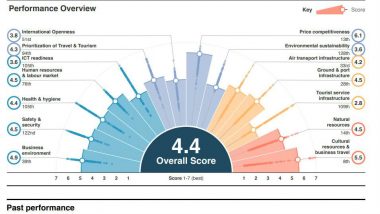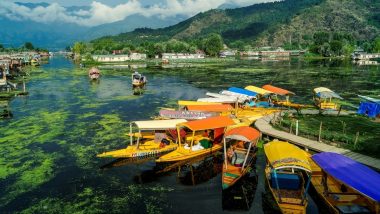New Delhi, September 4: India has moved up six places to rank 34th on world travel and tourism competitiveness index, driven by rich natural and cultural resources and strong price competitiveness, a WEF report said on Wednesday. India's ranking improved from 40th to 34th, the greatest improvement over 2017 among the top 25 per cent of all countries ranked in the report. Davos: What is the World Economic Forum 2019 Meet About?.
"India, which accounts for the majority of South Asia's T&T (travel and tourism) GDP, remains the sub-region's most competitive T&T economy, moving up six places to rank 34th globally," the report said. As per the report, China, Mexico, Malaysia, Thailand, Brazil and India -- which are not high-income economies but rank in the top 35 in the overall list -- stand out in the Cultural Resources and Business Travel Pillar through their combination of rich natural and cultural resources and strong price competitiveness.
"India showed the greatest percentage improvement to its overall Travel & Tourism Competitiveness Index (TTCI) score, which has helped it become the only lower-middle income country in the top 35," the report said and lauded its natural and cultural assets and price competitiveness. From a sub-regional perspective, the nation (India) has better air infrastructure (33rd) and ground and port infrastructure (28th), international openness (51st) and natural (14th) and cultural resources (8th).
Compared to global benchmarks, the country can also add price competitiveness (13th) to its roster of strengths, the report noted. "India also greatly improved its business environment (89th to 39th), overall T&T policy and enabling conditions (79th to 69th), infrastructure (58th to 55th) and information and communications technology (ICT) readiness (112th to 105th)," it noted.
India has moved up 6 places on World Travel and Tourism Competitiveness Index, with 40th rank in 2017 to 34th in 2019, as per World Economic Forum report. pic.twitter.com/hAN5qzANZ3
— ANI (@ANI) September 4, 2019
However, India still needs to enhance its enabling environment (98th), tourist service infrastructure (109th) and environmental sustainability (128th), the report said. The Travel & Tourism Competitiveness Index (TTCI), that covered 140 economies, measures the set of factors and policies that enable sustainable development of travel and tourism sector which contributes to the development and competitiveness of a country.
Spain held on to the top spot in the World Economic Forum's (WEF) latest Travel and Tourism Competitiveness Report (TTCR), which ranked 140 countries on their relative strengths in global tourism and travel. Spain was followed by France, Germany and Japan, with the United States replacing the UK in the top five. Gender Violence: Hundreds Protest Against South Africa's 'Femicide Epidemic' at World Economic Forum.
Others in the top 10 list include the United Kingdom at the 6th place, Australia (7th), Italy (8th), Canada (9th) and Switzerland (10th). The report further added that Asia-Pacific was one of the fastest-growing travel and tourism regions in this year's ranking. Japan remains Asia's most competitive travel and tourism economy, ranking 4th globally, while China is by far the largest travel and tourism economy in Asia-Pacific and 13th most competitive globally (up two spots).
The Philippines has shown improvement, moving up four places to rank 75 globally. Pakistan (121st) remains the least competitive country in South Asia when it comes to T&T, including the region's least favourable safety and security (134th) conditions. The biennial study showed resilient growth in travel and tourism sector, with scores rising in most countries, but also warned of an approaching 'tipping point', where factors like less expensive travel and fewer tourist barriers increase demand to unsustainable levels.
"Countries must look beyond their short-term gains from travel and tourism to ensure a positive future for their economies. Travel and tourism can drive economies, but only if policy-makers ensure proper management of their tourism assets, which requires a holistic, multistakeholder approach," said Lauren Uppink, Head of Aviation, Travel and Tourism at WEF.
The 140 economies were ranked in four sub-indexes: enabling environment, travel and tourism policy and enabling conditions, infrastructure, and natural and cultural resources. Together, these four sub-indexes include a total of 14 pillars, which are used to score a country's overall travel and tourism competitiveness.













 Quickly
Quickly





















